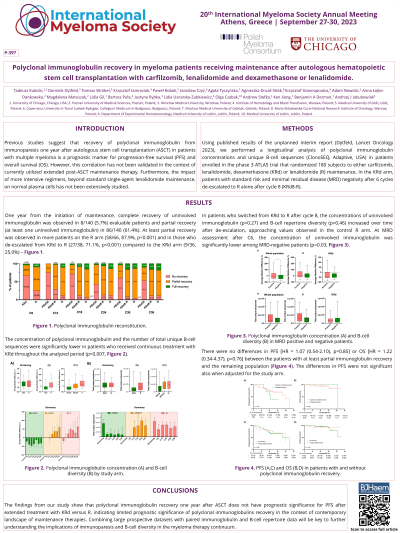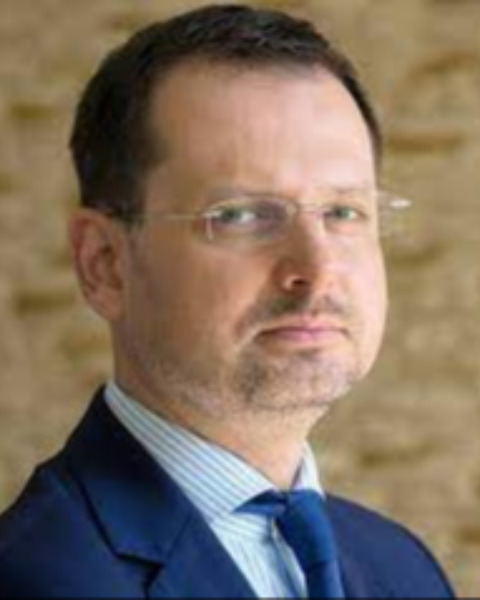Myeloma Microenvironment and immune profiling
Poster Session 3
P-397: Polyclonal immunoglobulin recovery in myeloma patients receiving maintenance after autologous hematopoietic stem cell transplantation with carfilzomib, lenalidomide and dexamethasone or lenalidomide.
Friday, September 29, 2023
1:15 PM - 2:15 PM EEST


Dominik Dytfeld, MD, PhD
Assistant Professor
Department of Hematology and Bone Marrow Transplantation, Karol Marcinkowski University of Medical Sciences, Poznań, Poland
Poznań, Poland
Introduction: Previous studies suggest that recovery of polyclonal immunoglobulin from immunoparesis one year after autologous stem cell transplantation (ASCT) in patients with multiple myeloma is a prognostic marker for progression-free survival (PFS) and overall survival (OS). However, this correlation has not been validated in the context of currently utilized extended post-ASCT maintenance therapy. Furthermore, the impact of more intensive regimens, beyond standard single-agent lenalidomide maintenance, on normal plasma cells has not been extensively studied.
Methods: Using published results of the unplanned interim report (Dytfeld, Lancet Oncology 2023), we performed a longitudinal analysis of polyclonal immunoglobulin concentrations and unique B-cell sequences in patients enrolled in the phase 3 ATLAS trial that randomized 180 subjects to either carfilzomib, lenalidomide, dexamethasone (KRd) or lenalidomide (R) maintenance. In the KRd arm, patients with standard risk and minimal residual disease (MRD) negativity after 6 cycles de-escalated to R alone after cycle 8.
Results: One year from the initiation of maintenance, complete recovery of uninvolved immunoglobulin was observed in 8/140 (5.7%) evaluable patients and partial recovery (at least one uninvolved immunoglobulin) in 86/140 (61.4%). At least partial recovery was observed in more patients on the R arm (58/66, 87.9%, p< 0.001) and in those who de-escalated from KRd to R (27/38, 71.1%, p< 0.001) compared to the KRd arm (9/36, 25.0%). The concentration of polyclonal immunoglobulin and the number of total unique B-cell sequences were significantly lower in patients who received continuous treatment with KRd throughout the analyzed period (cycles 6, 12, 18, 24, 30, 36). In patients who switched from KRd to R after cycle 8, the concentrations of uninvolved immunoglobulin and B-cell repertoire diversity increased over time after de-escalation, approaching values observed in the control R arm. At MRD assessment after C6, the concentration of uninvolved immunoglobulin was significantly lower among MRD-negative patients (p=0.03). There were no differences in PFS [HR = 1.07 (0.54-2.10), p=0.85] or OS [HR = 1.22 (0.34-4.37), p=0.76] between the patients with at least partial immunoglobulin recovery and the remaining population. The differences in PFS were not significant also when adjusted for the study arm.
Conclusions: The findings from our study show that polyclonal immunoglobulin recovery one year after ASCT does not have prognostic significance for PFS after extended treatment with KRd versus R, indicating limited prognostic significance of polyclonal immunoglobulins recovery in the context of contemporary landscape of maintenance therapies
Methods: Using published results of the unplanned interim report (Dytfeld, Lancet Oncology 2023), we performed a longitudinal analysis of polyclonal immunoglobulin concentrations and unique B-cell sequences in patients enrolled in the phase 3 ATLAS trial that randomized 180 subjects to either carfilzomib, lenalidomide, dexamethasone (KRd) or lenalidomide (R) maintenance. In the KRd arm, patients with standard risk and minimal residual disease (MRD) negativity after 6 cycles de-escalated to R alone after cycle 8.
Results: One year from the initiation of maintenance, complete recovery of uninvolved immunoglobulin was observed in 8/140 (5.7%) evaluable patients and partial recovery (at least one uninvolved immunoglobulin) in 86/140 (61.4%). At least partial recovery was observed in more patients on the R arm (58/66, 87.9%, p< 0.001) and in those who de-escalated from KRd to R (27/38, 71.1%, p< 0.001) compared to the KRd arm (9/36, 25.0%). The concentration of polyclonal immunoglobulin and the number of total unique B-cell sequences were significantly lower in patients who received continuous treatment with KRd throughout the analyzed period (cycles 6, 12, 18, 24, 30, 36). In patients who switched from KRd to R after cycle 8, the concentrations of uninvolved immunoglobulin and B-cell repertoire diversity increased over time after de-escalation, approaching values observed in the control R arm. At MRD assessment after C6, the concentration of uninvolved immunoglobulin was significantly lower among MRD-negative patients (p=0.03). There were no differences in PFS [HR = 1.07 (0.54-2.10), p=0.85] or OS [HR = 1.22 (0.34-4.37), p=0.76] between the patients with at least partial immunoglobulin recovery and the remaining population. The differences in PFS were not significant also when adjusted for the study arm.
Conclusions: The findings from our study show that polyclonal immunoglobulin recovery one year after ASCT does not have prognostic significance for PFS after extended treatment with KRd versus R, indicating limited prognostic significance of polyclonal immunoglobulins recovery in the context of contemporary landscape of maintenance therapies
